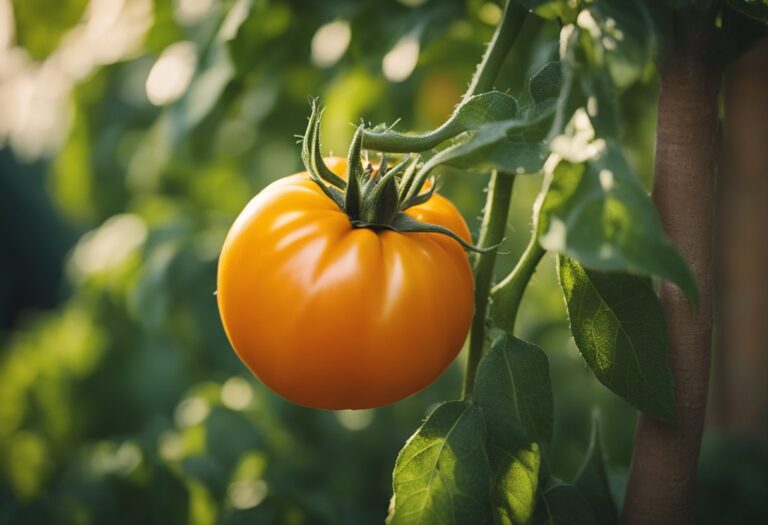Tomato Fruit Worms: How to Identify and Control Them
If you’re a gardener, you know that tomato plants are a popular choice for growing your own produce. However, one of the most common problems tomato growers face is the presence of tomato fruit worms. These pests can cause significant damage to your tomato plants and greatly reduce your yield. In this article, we’ll discuss what tomato fruit worms are, how to identify them, and strategies for controlling them.

Tomato fruit worms are the larvae of a species of moth, and they can be found throughout most of the United States. These pests can cause significant damage to tomato plants by burrowing into the fruit and feeding on the flesh inside. If left unchecked, tomato fruit worms can quickly destroy an entire crop of tomatoes.
Fortunately, there are several strategies you can use to prevent and control tomato fruit worms. By understanding these pests and taking the appropriate steps, you can protect your tomato plants and ensure a healthy, bountiful harvest. Let’s dive in and learn more about tomato fruit worms and how to manage them.
Key Takeaways
- Tomato fruit worms are a common pest that can cause significant damage to tomato plants.
- There are several prevention strategies you can use to protect your tomato plants from these pests.
- Natural predators, biological control, and chemical control methods can all be effective in managing tomato fruit worm infestations.
Understanding Tomato Fruit Worms

Tomato fruit worms are a common pest that can cause significant damage to your tomato plants. In this section, you’ll learn about the life cycle of tomato fruit worms and how to identify them.
Life Cycle of Tomato Fruit Worms
Tomato fruit worms, also known as corn earworms or cotton bollworms, go through several stages in their life cycle. They start as eggs, which are laid on the leaves and stems of tomato plants. The eggs hatch into small larvae, which then begin feeding on the tomato plant.
As the larvae grow, they molt several times, shedding their skin as they go. They continue to feed on the tomato plant, often burrowing into the fruit itself. Eventually, the larvae pupate, forming a cocoon in the soil. After a few weeks, adult moths emerge from the cocoon, and the cycle begins again.
Identifying Tomato Fruit Worms
Identifying tomato fruit worms can be challenging, as they are small and often blend in with the tomato plant. However, there are a few signs to look out for. The first is the presence of small holes in the fruit, which may be an indication that the larvae have burrowed inside.
You may also notice small droppings near the fruit, which can be a sign that the larvae are feeding. Finally, you may see the larvae themselves, which are typically green or brown and can grow up to 2 inches in length.
By understanding the life cycle of tomato fruit worms and knowing how to identify them, you can take steps to protect your tomato plants and minimize the damage caused by these pests.
Prevention Strategies

When it comes to tomato fruit worms, prevention is the best strategy. By implementing the following prevention strategies, you can reduce the risk of an infestation and protect your tomato plants.
Cultural Practices
Cultural practices are an effective way to prevent tomato fruit worms. Here are some cultural practices that you can follow:
-
Crop rotation: Rotate your tomato plants with non-solanaceous crops such as beans, peas, or corn. This helps to break the life cycle of tomato fruit worms and reduce the risk of an infestation.
-
Sanitation: Keep your garden clean and remove any fallen fruit or plant debris. This helps to reduce the habitat for tomato fruit worms and other pests.
-
Companion planting: Plant companion plants such as marigolds, basil, or garlic around your tomato plants. These plants repel tomato fruit worms and other pests.
Physical Barriers and Traps
Physical barriers and traps are another effective way to prevent tomato fruit worms. Here are some physical barriers and traps that you can use:
-
Floating row covers: Cover your tomato plants with floating row covers. This helps to prevent adult moths from laying their eggs on your tomato plants.
-
Sticky traps: Hang sticky traps around your tomato plants. This helps to trap adult moths and reduce the risk of an infestation.
-
Handpicking: Handpick any tomato fruit worms that you see on your tomato plants. This helps to reduce the population of tomato fruit worms and prevent an infestation.
By following these prevention strategies, you can protect your tomato plants from tomato fruit worms and enjoy a healthy harvest.
Natural Predators and Biological Control
If you want to control tomato fruitworms without using harmful chemicals, you can rely on natural predators and biological control methods. There are two main types of biological control: beneficial insects and microbial insecticides.
Beneficial Insects
Beneficial insects are natural predators that can help control tomato fruitworms. These insects include parasitic wasps, big-eyed bugs, and minute pirate bugs. These insects feed on tomato fruitworm eggs and larvae, effectively reducing their population.
You can attract beneficial insects to your garden by planting flowers that produce nectar and pollen. Some good choices include marigolds, zinnias, and sunflowers. You can also purchase beneficial insects from garden supply stores and release them in your garden.
Microbial Insecticides
Microbial insecticides are made from naturally occurring bacteria, fungi, or viruses that can kill tomato fruitworms. These insecticides are safe for humans and the environment and can be used in organic gardening.
One effective microbial insecticide for controlling tomato fruitworms is Bacillus thuringiensis (Bt). Bt is a bacteria that produces a toxin that is lethal to tomato fruitworms. You can spray Bt on your tomato plants to control tomato fruitworms.
Another effective microbial insecticide is spinosad. Spinosad is made from a soil bacteria and is toxic to tomato fruitworms. You can spray spinosad on your tomato plants to control tomato fruitworms.
Using natural predators and biological control methods can help you control tomato fruitworms without harming the environment or your health. By attracting beneficial insects and using microbial insecticides, you can reduce the population of tomato fruitworms in your garden and enjoy a healthy harvest of tomatoes.
Chemical Control Methods
If you have a severe infestation of tomato fruit worms, chemical control may be necessary. There are two main types of chemical control methods: organic pesticides and synthetic insecticides.
Organic Pesticides
Organic pesticides are made from natural ingredients and are considered safer to use than synthetic insecticides. Some examples of organic pesticides that can be used to control tomato fruit worms include:
-
Bacillus thuringiensis (Bt): This is a naturally occurring bacteria that produces toxins that are toxic to tomato fruit worms. Bt is available in powder or liquid form and can be sprayed directly onto the tomato plants.
-
Spinosad: This is a natural insecticide made from soil bacteria. It is available in liquid or powder form and can be sprayed directly onto the tomato plants.
-
Neem oil: This is a natural oil extracted from the neem tree. It can be used to control a variety of pests, including tomato fruit worms. Neem oil can be mixed with water and sprayed directly onto the tomato plants.
Synthetic Insecticides
Synthetic insecticides are made from chemicals and are generally more effective than organic pesticides. However, they can also be more toxic to humans and the environment. Some examples of synthetic insecticides that can be used to control tomato fruit worms include:
-
Carbaryl: This is a broad-spectrum insecticide that is effective against a variety of pests, including tomato fruit worms. Carbaryl is available in liquid or powder form and can be sprayed directly onto the tomato plants.
-
Malathion: This is another broad-spectrum insecticide that is effective against tomato fruit worms. Malathion is available in liquid or powder form and can be sprayed directly onto the tomato plants.
When using any type of chemical control method, it is important to follow the instructions carefully. Wear protective clothing and use caution when applying the pesticide. Always read the label and follow the recommended application rates.
Monitoring and Managing Infestations
Scouting for Worms
To monitor for tomato fruit worms, you should regularly inspect your plants for eggs, larvae, and damage. According to UCANR, you should begin scouting for eggs when a significant number of green fruit are one inch in diameter. Conduct a 5-minute search of leaves for eggs. If eggs are found, a treatment may be warranted. Later in the season, sample both leaves and fruit when monitoring for caterpillars (tomato fruitworm, beet armyworm, etc.).
When scouting for larvae, look for holes in the fruit and frass (excrement) on leaves and fruit. You may also notice the larvae themselves, which can vary in color from green to brown with white stripes.
Threshold Levels for Action
It’s important to know when to take action against tomato fruit worms. According to Gardening Chores, a threshold of 5% of fruit with damage is often used as a trigger for treatment. However, this threshold may vary depending on the stage of growth and marketability of the fruit.
If you do decide to take action against an infestation, there are both organic and chemical control methods available. Organic methods include using row covers or fine insect netting to exclude the moths altogether, handpicking larvae, and using Bacillus thuringiensis (BT) sprays. Chemical control methods include using insecticides such as spinosad, carbaryl, and permethrin. However, it’s important to read and follow all label instructions when using chemical control methods.
By regularly monitoring for tomato fruit worms and taking action when necessary, you can help protect your tomato plants and ensure a healthy harvest.
Frequently Asked Questions
How can I treat tomato fruitworm infestations?
There are several methods for treating tomato fruitworm infestations. One effective option is to use Bacillus thuringiensis, a natural bacterial insecticide that targets the fruitworm larvae. Another option is to apply neem oil or insecticidal soap to the plants once a week and after rain. Handpicking the worms off the plants is also an option, but can be time-consuming for larger gardens.
What are the common symptoms of tomato fruitworm damage?
The most common symptom of tomato fruitworm damage is holes in the fruit, often near the stem end. You may also notice frass (insect excrement) on the fruit or around the base of the plant. In severe cases, the fruit may be completely destroyed or rot prematurely.
Are tomato fruitworms harmful to humans or pets?
No, tomato fruitworms are not harmful to humans or pets. They are primarily a pest of tomato plants and other related crops.
Can you eat tomatoes that have been affected by fruitworms?
In general, it is not recommended to eat tomatoes that have been affected by fruitworms. The damage caused by the worms can lead to rot and spoilage, making the fruit inedible.
What methods are effective for preventing tomato fruitworm attacks?
There are several methods for preventing tomato fruitworm attacks. One effective option is to use row covers or fine insect netting over your mature tomato plants to keep them safe from the moths that lay the eggs. Another option is to release beneficial parasites, such as Trichogramma wasps, which can help control the fruitworm population.
Which pesticides are recommended for controlling tomato fruitworms?
There are several pesticides that can be effective for controlling tomato fruitworms. Spinosad, a natural, broad-spectrum insecticide made from soil microbes, is one option. Sevin, a carbamate insecticide, is another option that can be effective when used every 5-7 days when fruit begins to set. However, it is important to follow the instructions carefully and use pesticides only as directed to avoid harming beneficial insects and other wildlife.


